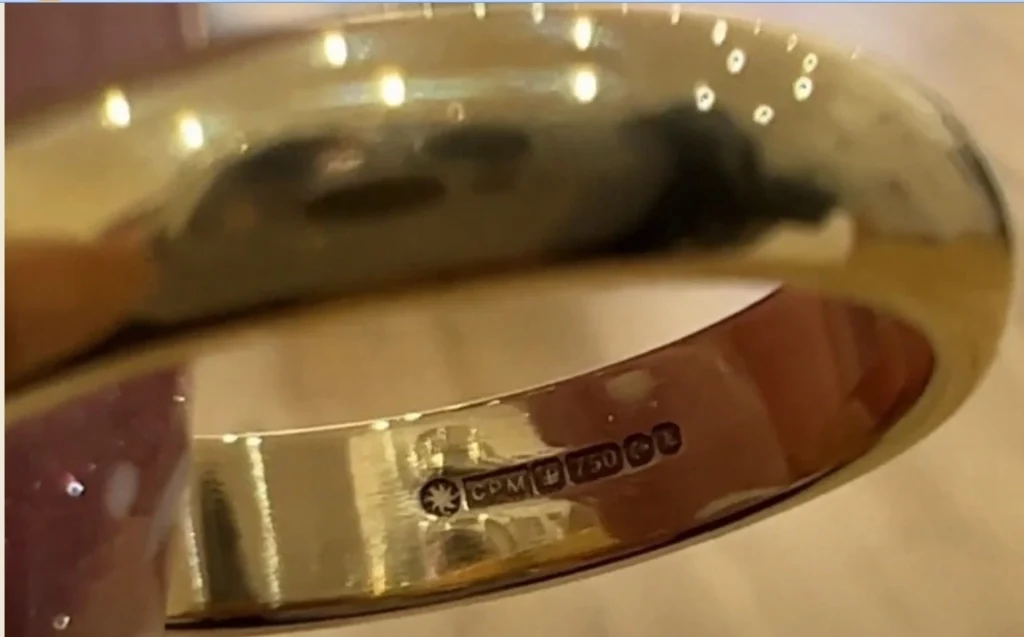
What Are The Gold Identification Marks On Jewelry?
The gold identification marks are numbers, letters, and symbols engraved on a piece of jewelry that describe the verified seller’s mark, the official assay authority mark, the gold indication mark, the date mark, and the gold fineness mark revealing the percentage of pure gold inside it. These marks are also called hallmarks.
The hallmarks are generated by an authentic registered jewelry maker/seller or by an official assay authority. The rule of hallmarking varies from country to country.
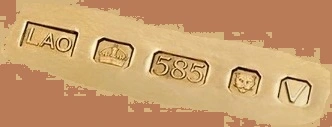
In this article, you will learn in-depth information about the gold identification hallmarks on jewelry and the meaning of karats associated with the gold.
The Term Gold Purity Hallmark

A gold purity hallmark is simply a stamp or mark embossed on any part of the gold bar or jewelry by the official assessment authority or manufacturer depicting the content of pure gold inside it.
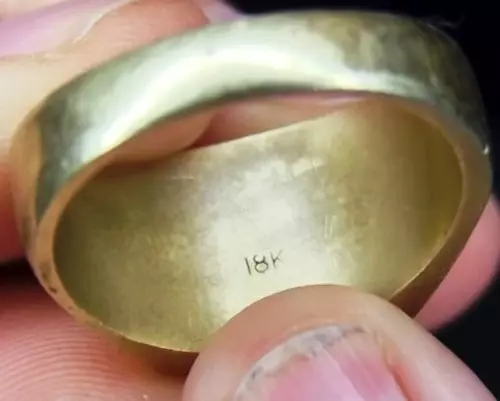
It is indicated by CT or K mark, e.g. 24CT, 18CT or 24K or 18K, etc. The 1K is the lowest gold purity level and 24K is the highest max purity level. The gold jewelry having purity hallmarks has more market acceptability and value. In the global market, the price of gold is fixed in USD.
Carat or Karat
The Gold purity is mentioned in Carats in some countries and abbreviated by ct or CT (e.g. 24CT, 18CT, 14CT, 9CT, etc). It is also written as Karat and the symbol used is K or KT (e.g. 24K, 22K, 18K, 14K, 10K, etc). The 24K has the highest gold price and is normally available in bullion form i.e. bar or brick.
In the United States of America (USA), the measuring unit of gold is Karat. However, in the UK, the exact measuring unit of gold used is by the name of Carat. Both use gold proportion by 24 parts being the maximum. Normally, the carat is specifically used for measuring the weight of diamonds (gemstones) in the USA.
The people in different regions use both the terms carat and karat reciprocally for measuring the gold. So, one should not be confused and consider the context of the precious metal in focus discussion or transaction.
Types of Gold Hallmark Symbols
There are different types of gold hallmark symbols used in different parts of the world. However, certain gold identification symbols are standardized by the international gold regulatory authority and are acceptable and used globally.
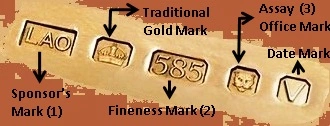
There are five hallmark symbols you can see on a gold bar or jewelry as appearing in the above picture. However, the Sponsor’s Mark, Fineness Mark, and Assay Office Mark are officially compulsory to be stamped on a piece of standard gold jewelry or brick.
The different types of obligatory gold hallmark symbols are known as:
Sponsor’s Mark
The identification mark of the seller is also called Sponsor’s Mark. This is the trademark of the brand/seller who is registered with the assay office and presented its gold products for hallmarking.

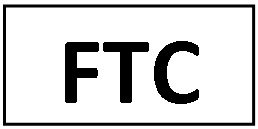
Normally, the sponsor’s mark comprises 2 or 3 letters within a shape (square, rectangle or circle) or without any shape and can be in Upper Case or Lower Case.
Fineness Mark
The fineness mark signifies two things.
The first thing it states that what type of metal a person holds in hand. It is indicated by the shape embossed on the metal or jewelry. The second thing is the standard gold purity code embossed on that metal or jewelry, which portrays pure gold content.

Gold
Octagon Shape Hallmark Stamp – 14K

Silver
Oval Shape Hallmark Stamp – 999

Platinum
Pentagon Shape Hallmark Stamp – 900

Palladium
Trapezium Shape Hallmark Stamp Up Till 2009 – 950
Palladium
Small Circles Shape Hallmark Stamp 2010 Onward – 500
As shown in the above table, the bar or jewelry made up of GOLD is engraved with an octagon shape symbol, and the content of pure gold is mentioned in codes e.g. 585 or 750, etc (585 means 14-carat gold, and 750 means 18-carat gold).
The oval shape indicates that the precious metal is silver, the house shape engraved on the jewelry indicates it’s platinum, and the trapezium shape (out of 4 sides two sides are equal) shows the item was palladium up till 2009, but from 2010 onward palladium mark now embossed comprises of 3 circles joint together.
All the precious metals have a millesimal number stamp inside the indicative shapes. These numbers explain to the reader the percentage of precious metal and other metals inside the precious metal.
Assay Office Mark
The assay office mark indicates the stamp of the official authority who registered the seller, tested, and hallmarked the gold items including jewelry or gold bars. In every country, there are official gold assay authorities established by the state.
In the Uk, there are four assay offices, there names and associated marks are presented below.

London Assay Office Mark

Sheffield Assay Office Mark

Edinburgh Assay Office Mark

Birmingham Assay Office Mark
Optional Identification Hallmarks
The following are optional identification marks. Their requirement is not officially significant. However, you may experience any of these marks on the jewelry items.
Hallmark Date Letters (Date Mark)
The date mark reveals the year in which the gold item was tested and hallmarked by the assay office. The gold hallmark date letters are considered optional.
The examples of gold hallmark date letters are, v = 2020, w = 2021, x = 2022, y = 2023, and z = 2024. Some other date marks are presented in the following picture.
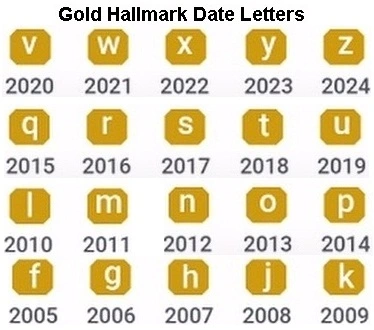
Traditional Fineness Symbols
Certain fineness symbols were used in the past for marking precious metals. But, now these symbols are totally out of fashion.
The traditional fineness symbols comprise Sterling Silver, Gold, Britannia Silver, Palladium, and Platinum marks. The stamps of associated precious metals are presented hereunder in the image for the reader’s information.
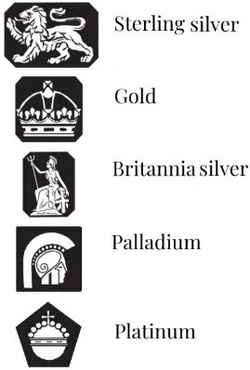
International Convention Marks
The International Convention on Hallmarking includes all the signatory countries who agreed on the common standard of gold marks. These marks are called Common Control Marks (CCM).
These precious metal symbols are used and accepted equally in all the 20 member countries including the UK, Ireland, Denmark, Poland, Switzerland, Norway, and Austria etc.
The symbols of international convention marks are provided in the following image format.
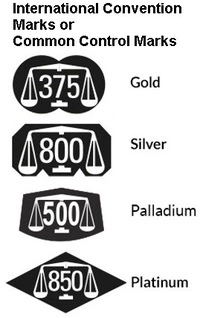
Additional Letter Markings Identification Stamp
Additional letter markings on gold jewelry include P, GP, GF, GE, or GEP, HGE, or RGP. These letters indicate the quantity and quality of gold and other materials used to formulate a jewelry article.
Let’s understand the meaning of each letter stamp. This information will assist the readers in making better buying decisions at jewelry shops.
Precious Metals Weight Exempt from Hallmarks
By law, certain weighted precious metals are exempt from hallmarked stamps. These weight limits are considered as under legal weight.
All the precious metals above the following weight limits are subject to hallmarking.
How To Locate Hallmark On Gold Jewelry
When you visit a shop or at home, you can locate the hallmark on gold jewelry normally punched in tiny numbers, letters, or symbols placed at prominent places on different jewelry items. At times, you need a magnifying glass to read the marks.
The position of hallmarks on different jewelry items is explained below to help readers instantly identify the hallmark location.
Ways To Measure The Purity of Gold
We all know that the pure gold (99.9 % – 24K) is soft. It can be traded in the form of bullion (bars / bricks / biscuits). However, it cannot be used for making jewelry. Pure gold, when mixed with other metals like zinc or silver becomes durable and available for making jewelry.

There are two systems used for measuring the purity of gold (fineness) in the world. These are namely:
The Karatage System
This gold purity measuring system is successfully used only in Canada and the United States of America (USA). This system is also written as the gold caratage system.
A Karat is a unit that measures the purity of gold in parts or fractions of 24 (max gold fineness). For example, 22K gold is calculated as 22/24 = 0.916 or 91.6% solid pure gold weight in a gold item. Karat reflects the weight or percentage of pure gold and alloy in a gold bar. The superior karat gold means, the quantity of pure gold is high.
When you see a 24K mark on the gold bar, it means the item has the max gold purity level with 99.9% pure gold content inside it. After 24K the lower karats grade following are 23K, 22K, 21K, 20K, 19K, 21K, 18K, 15K, 14K, 10K, 9K, and 8K etc.
The latest day price of each gold karat in global currencies can be checked at the gold price calculator free tool on the site.
The Millesimal Fineness System
In gold jewelry or gold biscuits, the content of pure gold measured in parts per 1000 (ppt) by weight is called the Millesimal Fineness System. It means, keeping in view the example of 14-carat gold, 585 parts pure gold per 1000 by weight. The remaining 415 parts are alloy.
In the Millesimal Fineness System, the fineness of gold is indicated in three numbers or embossed with a 3-digit stamp. For instance, if you see the 585 three-digit number engraved on the gold jewelry it means 58.3% pure gold and the remaining 41.7% other metals in the gold item.
In general, the series of three numbers stamped is universally read in the following manner:
| 3 Digit Stamp | Gold Fineness | Karats |
| 999 | 99.9% | 24K |
| 995 | 99.5% | |
| 990 | 99.0% | |
| 958 | 95.8% | 23K |
| 916 or 917 | 91.6% or 91.7% | 22K |
| 833 | 83.3% | 20K |
| 750 | 75.0% | 18K |
| 625 | 62.5% | 15K |
| 583 or 585 or 575 | 58.3% | 14K |
| 417 | 41.7% | 10K |
| 375 | 37.5% | 9K |
| 333 | 33.3% | 8K |
10K is the lowest gold available in the USA market. Similarly, 8K is the lowest gold used in the German market. You can use the gold price calculator on the site to determine the current gold rate in the market in your currency with the desired gold carat.
Need of Gold Hallmark Identification
Now the question arises as to why there is a need to punch gold hallmark identification on the gold made-ups in the modern world.
The answer is:
The history of gold hallmark symbols is very old. The mankind for last many centuries embossed markings on gold to regulate its purity and value. The hallmark designs or gold karat code (i.e. 22K or 916) may change, as time passes and now more refined hallmarks are punched on gold ornaments.
Similarly, the different weight units were in practice in different parts of the world at different times. The old civilizations used grain, and penny weights to measure the value of gold. But, now in the modern world metric system is applied and gold weight is measured in grams, troy ounces, and kg.
One can convert Gram to Kg or Tola to Masha or Gram to Ounce etc using the gold weight converter tool on the site.
Legal Importance of Gold Identification Marks
It is to be noted that the gold karat code is legally mandatory on gold jewelry in some countries like the UK, France, Spain, Switzerland, and India.
But, in certain countries, there is no compulsion to assign gold hallmark numbers. A goldsmith places his self-generated identification marks on his gold products. So the gold from such countries needs to be examined and tested to check for the gold fineness in the jewelry.
What Does Karat Gold Mean?
The first factor that a customer sees before buying a gold item is its fineness level and the current gold price in the market. The gold fineness/purity level is indicated by karat or carat. Because the gold purity is directly related to the worth of the gold item.
The gold karat explained the fineness of gold in a jewelry item. We all know that the gold purity is evaluated in karats (e.g. 24k, 22kt). The karat expresses the number of gold parts in proportion to 24 Karat in a gold jewelry or gold bar. 24K is the purest form of gold having 24 parts of pure gold alloyed with zero mixing of the other metals.
We are illustrating hereunder some of the common gold stamps that you will normally find on gold jewelry or gold bricks and explaining their value meaning.
24K (24KT or 24CT) Stamp
When you see the 24K mark on any gold item, immediately understand that the item has 99.9% pure gold karat percentage with almost 0% mixing. A 24K item can be hallmarked with a 999 stamp. It’s a soft gold. It is not used for making jewelry made-ups as it is non-durable. It is commonly found in the form of gold bullion.
22K (22KT or 22CT) Stamp
A 22K stamp means the gold item holds 91.6 % pure gold and 8.4% mixing of other metals in the gold jewelry. It is also normally engraved with a 916 or 917 hallmark. It is more durable than 24K gold. The 22CT gold article means the gold used comprises 22 parts of fine gold and 2 parts of other material.
18K (18KT or 18CT) Stamp
The 18K stamp on a gold item denotes that the jewelry has 75% pure gold content and the remaining 25% other metals like zinc, copper, or silver. It is also stamped with a 750 mark. It is one of the most common karats used in making gold jewelry as it is hard and durable. The 18K gold is available in white, rose, and yellow colors.
14K (14KT or 14CT) Stamp
A 14K stamp code reveals that the jewelry has 58.3% pure gold and the remaining 41.7% other metals. You can say that the said gold item has 14 parts of fine gold and 10 parts of non-gold metals. It is carved with a 583 hallmark code. The 14 Karat is frequently used in making gold jewelry made-ups. This jewelry is stronger than 18K.
10K (10KT or 10CT) Stamp
A 10K stamp points out that the gold item comprises 41.7% pure gold content and the remaining 58.3% mixing of other metals. The gold jewelry is hallmarked with a 417 mark. It is also said that the gold ornament under evaluation has 10 parts of real gold and 14 parts of non-gold matter. You will find this jewelry most durable and can be used on day-to-day work.
9K (9KT or 9CT) Stamp
The 9K gold stamp means the gold jewelry holds 9 parts of real gold and 15 parts of other material. In other words, 9KT gold has 37.5% actual gold and the rest 62.5% mixing of additional substance (like silver or zinc, etc). The 9K gold holds a 375 code hallmark on it. It’s affordable gold jewelry that can be used in routine life.
Gold Karat List
Karat signifies the ratio of pure gold to the other metals. The other metals could be silver, copper, palladium, or zinc.
Gold purity is divided into 24 parts and each part is called a karat. Hence, the karat scale has a minimum of 1 karat and a maximum of 24 karats. It means the higher gold karat numbers have more pure gold and fewer other metals.
For the convenience of the readers, we are providing hereunder a complete gold karat numbers list starting from 24K to 1K, parts of gold, pure gold karat percentage, and alloy %
| Karats | Gold Parts | Pure Gold | Alloy |
|---|---|---|---|
| 24K | 24/24 | 99.9% | 0.1% |
| 23K | 23/24 | 95.8% | 4.2% |
| 22K | 22/24 | 91.7% | 8.3% |
| 21K | 21/24 | 87.5% | 12.5% |
| 20K | 20/24 | 83.3% | 16.7% |
| 19K | 19/24 | 79.2% | 20.8% |
| 18K | 18/24 | 75.0% | 25.0% |
| 17K | 17/24 | 70.8% | 29.2% |
| 16K | 16/24 | 66.7% | 33.3% |
| 15K | 15/24 | 62.5% | 37.5% |
| 14K | 14/24 | 58.3% | 41.7% |
| 13K | 13/24 | 54.2% | 45.8% |
| 12K | 12/24 | 50.0% | 50.0% |
| 11K | 11/24 | 45.8% | 54.2% |
| 10K | 10/24 | 41.7% | 58.3% |
| 9K | 9/24 | 37.5% | 62.5% |
| 8K | 8/24 | 33.3% | 66.7% |
| 7K | 7/24 | 29.2% | 70.8% |
| 6K | 6/24 | 25.0% | 75.0% |
| 5K | 5/24 | 20.8% | 79.2% |
| 4K | 4/24 | 16.7% | 83.3% |
| 3K | 3/24 | 12.5% | 87.5% |
| 2K | 2/24 | 8.3% | 91.7% |
| 1K | 1/24 | 4.2% | 95.8% |
